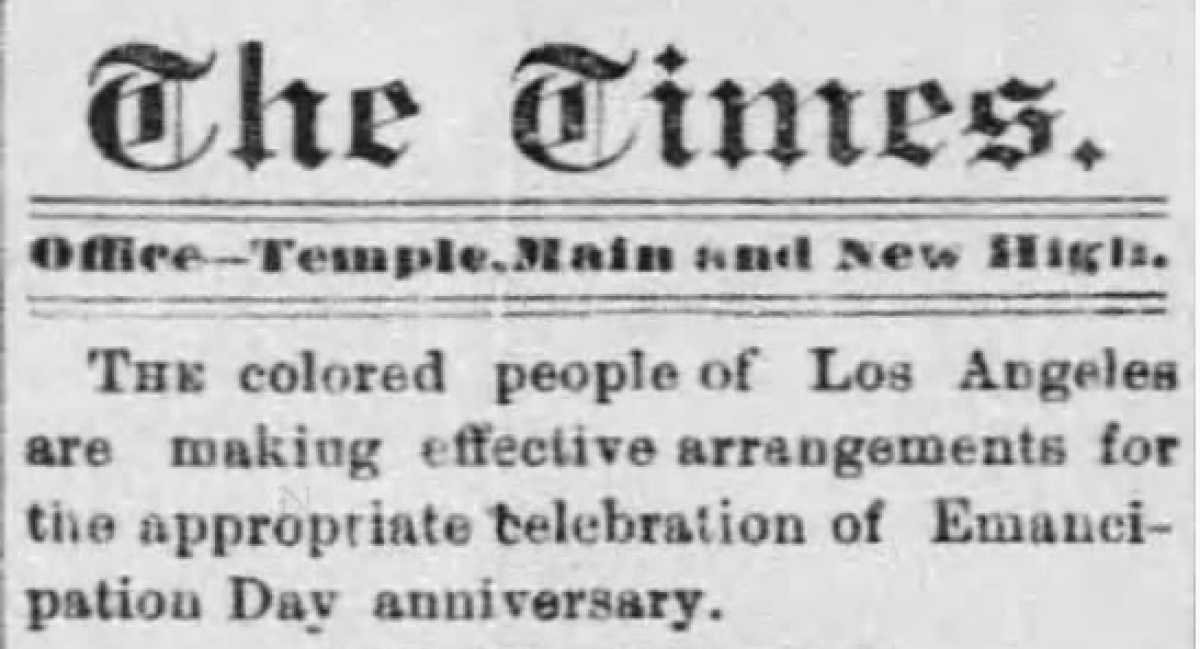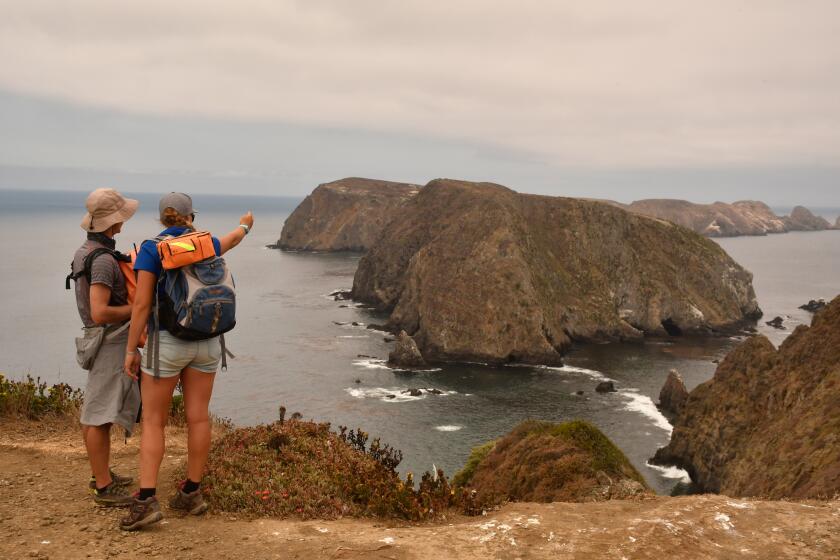Before Juneteenth was widely known, here’s how Black Angelenos celebrated emancipation
- Share via
The listing that ran in the Dec. 31, 1874, edition of the Los Angeles Herald was as short as it was dismissive.
“The ‘high-toned’ colored folks,” the unsigned story stated, “will celebrate the anniversary of their emancipation” on New Year’s Day with a dinner and dance.
But the blurb nevertheless remains significant: It’s one of the earliest documented records of African Americans in Los Angeles celebrating the end of slavery in the United States.
And parties, picnics and parades to mark the occasion have continued ever since with a batch of holidays.
Juneteenth, which falls on June 19 and references the day in 1865 when slaves in Texas found out about their freedom 2½ years after the Emancipation Proclamation, is just the most well-known.
But over the last 150-plus years, other dates served the same purpose: Jan. 1 (when the Emancipation Proclamation took effect in 1863), Sept. 22 (when President Lincoln signed it in 1862), and July 28 (the 14th Amendment was officially adopted on that date in 1868), among others.
A look through historical archives shows these jubilees were a barometer of their times.
One thing that never changed, though, was the overriding theme, one more resonant today than ever:
Black lives mattered.
***
Black people in California began to celebrate Jan. 1 as Emancipation Day as early as 1865 in San Francisco. But public celebrations in Los Angeles took longer to emerge.
For one, the population was minuscule in the wake of the Civil War: The 1870 U.S. census found only 134 Black people, less than 1% of all Los Angeles residents at the time. It was a city then dominated by white Southerners whose sympathies still lay with the defeated Confederacy.
But on April 12, 1870, more than 50 people gathered at what would become the First African Methodist Episcopal Church, the city’s first Black house of worship. The reason: the ratification of the 15th Amendment, which gave African American citizens the right to vote. There was a potluck with speeches and a dance where whites were invited. Later on that night, ecstatic parishioners took the party to Bunker Hill and blasted anvils into the sky at 4 in the morning.
Four days later, one of those partygoers, a barber named Lewis G. Green, tried to register to vote.
He was denied.
Alison Rose Jefferson, a historian who focuses on Black Los Angeles, said emancipation celebrations then weren’t predicated on set dates or even big events.
“It was always about the struggle for freedom,” she said. “Just being together informally was a form of emancipation.”

Eventually, Jan. 1 became the most popular date to celebrate as L.A.’s Black population grew because it coincided with New Year’s Day. Newspaper articles mention beach picnics in Redondo Beach and dances in downtown Los Angeles. For the 1896 Pasadena Tournament of Roses parade, local African Americans even entered two horse-drawn floats, “handsomely decorated and suitably inscribed in commemoration of the incidents which recall so much for their race,” according to a Los Angeles Herald story.
But most of the Emancipation Day commemorations centered on church, an apt setting for its most important feature: testimonials from former slaves.
One such event happened on Jan. 1, 1900, at Wesley Chapel Methodist Episcopal Church, which stood on what’s now skid row. The subject was personal for Pastor F.L. Donohoo: His mother was sold as a baby, and Donohoo remembered how his father was part of the Union regiment that freed his family.
Over three services that day, the Los Angeles Times reported, the Wesley Chapel congregation heard from people such as “Mr. Morton,” who talked about how “he was a poor slave boy with not even an education to aid him, but he has been able to accumulate considerable property and live a happy life.”
Another former slave, one “Mr. Sawyer,” told the audience he was there when the first Juneteenth happened “and praised God for freedom.”

Juneteenth didn’t warrant any further comment from Sawyer because it was still relatively unknown to locals; the earliest known celebration is an 1895 picnic at North Beach in Santa Monica attended by more than 200.
But it soon eclipsed Emancipation Day in popularity after tens of thousands of African Americans from Texas came to Southern California as part of the Great Migration and brought the Lone Star State tradition with them.
“The Texans had more of a party-type celebration than people here,” Jefferson said. “And people went to that.”
African Americans from San Bernardino to Long Beach, Bakersfield to Brawley, began to hold their own Juneteenths. But the biggest soiree was at the Elks temple in South L.A., where the fraternal order offered a carnival, a picnic and dancing until 1 in the morning.
By 1933, the Los Angeles Times explained the holiday to its mostly white readers as “What Independence Day is to all Americans; Cinco de Mayo to Mexicans, so ‘June Teenth’ is to the Negro of the United States.”

It became fixed enough on the Southern California African American imagination that in 1938, the resort town of Val Verde near Santa Clarita, known as the “Black Palm Springs,” chose June 19 as the date to start a bathhouse and swimming pool project where African Americans could swim and lounge in peace.
Marcus Hunter, chair of African American studies at UCLA, says Juneteenth also rose above other dates in California and beyond because of its symbolism.
“It’s a memory of slavery,” he said. “In a world without social media, how do you find out that you’re free two years after it actually happened? From black folks, not the federal government.”
Juneteenth has been celebrated in Los Angeles ever since, although Jefferson says it’s “truly” grown in stature over the last 30 years. But whatever the date, she argues it and its sister holidays drew their staying power because of the challenge it offered.
“It’s a way of calling to our citizens that although this freedom occurred,” Jefferson said, “there’s still some unfinished business.”
More to Read
Sign up for Essential California
The most important California stories and recommendations in your inbox every morning.
You may occasionally receive promotional content from the Los Angeles Times.














